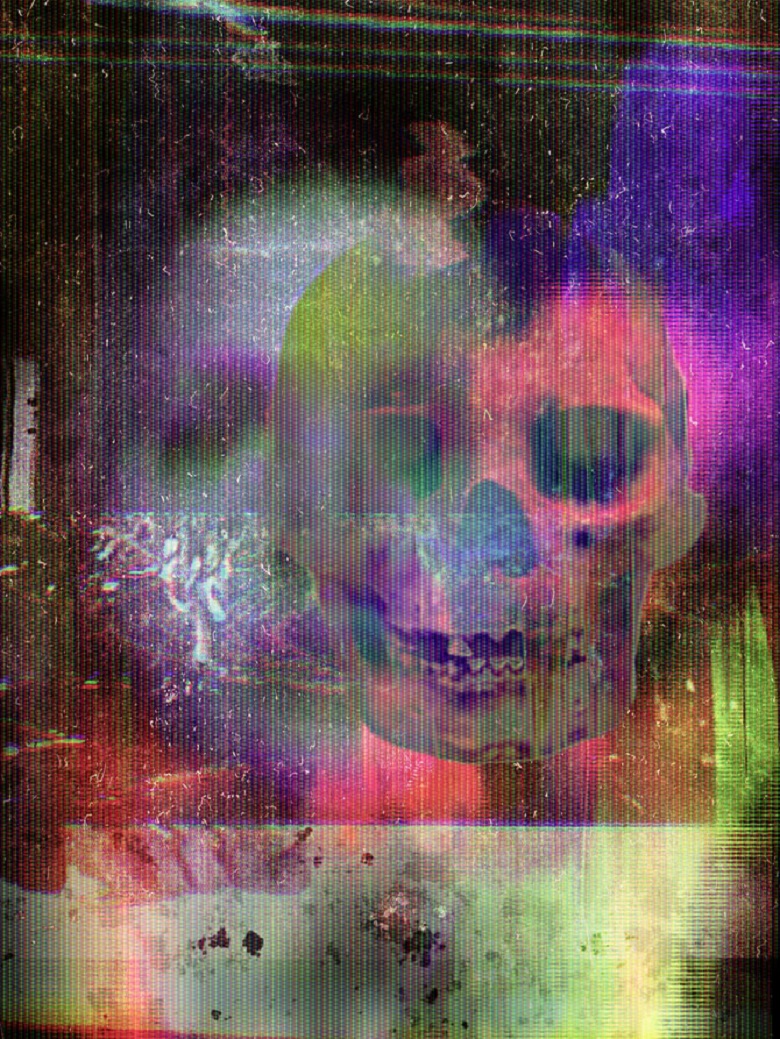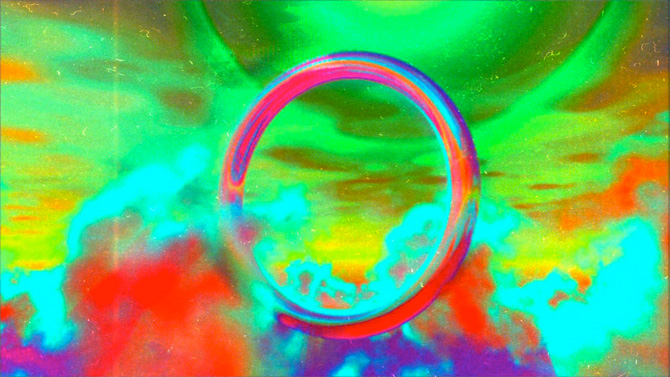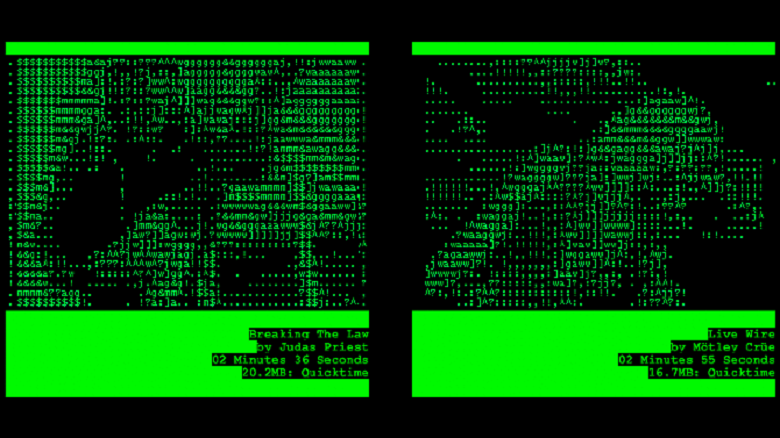
“Any computer-generated imageries tend to look cold when they are perfectly executed. But I just like things that are imperfect and decayed in general. So, I mix errors and dirt into my artworks to give it a little human touch. But I’m not sure if I ever use the term “glitch” to describe my work, and it’s never my central theme. I always put many other different elements such as scanned dirty iPad screen with fingerprints or analog feedback, things that are old and analog.The thing is that the concept of glitch is nothing new. Just try to think of distorted guitar sounds in rock music as an example. Distortion sound was originally a glitch that people try to eliminate when electric guitars came around. But it’s like one of the most natural sounds in pop/rock music since 1950’s. No one calls music with distorted guitar sounds glitch music, right? Technology fails and do a lot of cool things for artists that are originally unintended by the inventors. No big deal.
What’s important is the right combination between ideas and techniques to make things interesting. It’s always important to think before using those techniques and looks and figure out why they add meanings for my ideas. If not, I just leave those out of it. And as for the end result, the artwork is most successful when people don’t pay attention about the use of glitch or any other technical things and just focus on the message itself.”
– Yoshi Sodeoka, on spontaneity and error
Manipulating Audio-Visual Perception
A symbiotic relationship between the aural and the visual experiences of sound can often be seen in Sodeoka’s videos. From the minimalist white static and pulse-lines of Aditi (2005) to the electric vortex of Disc: Void (2009), and the more recent object-oriented visuals of the ongoing Sibyl series, Sodeoka reveals an experimental tendency towards the ways in which images can express sonic elements: how they can reflect one another aesthetically and also in a more visceral, experiential sense.
The aesthetic parallels play with the distinction between simplistic geometric shapes and complex, layered visualizations; both often rely on interlacing light to assail the viewer. The visualization of the sonic experience can also be found in Sodeoka’s rhythmic multiplication of objects within an otherwise still frame, and in the alternately sustained or jittering movements of this miscellany in response to recorded sound. This accompanying musical component is a primary element in Sodeoka’s work, as opposed to being an incidental addition onto the visuals.
The high-voltage shock of Bloodless, Empty Socket, for instance, exemplifies Sodeoka’s compression of bleeding color and image so that the undulating electronic sounds seem to direct the visuals. As the screen flares up into quickened heartbeats of venous blue and arterial red, a low reverb seems to circle inwards. Against the abstraction, images are revealed in a subliminal volley of detonations, Illuminati symbolism, and barely decipherable suggestions of a world that exists between the eye and the digital sphere of computer and television screens. Striations of colour, visions of laced acid, struggle into view as the oscillating sounds of Bloodless, Empty Socket evoke alien voices, flickering channels, and finally, photographic evidence of the human gaze. As an X-ray skull blinks across the image, the soundtrack makes fleeting reference to musical organization and harmony. Sodeoka’s visualizations gasp for clarity in the same pattern as the rise and fall, fade and emergence of the sound. In its own harmony with the conclusive drone, the turbulence comes to rest in the form of an electric orb–an all-seeing eye, an inhuman gaze, vacuous and overwhelming.
Universe / Calibration


Sodeoka’s videos may at times appear deceptively simple — almost child’s play with their shimmering orbs, splashes of watercoloured pixels and gleaming lines that appear to indiscriminately cut through the frames. An initial glance at the video Universe / Calibration divulges not much more than an inexplicable ring hovering in a stream of fluorescent clouds. There appears to be no narrative, yet Sodeoka manipulates the quizzical, eerie qualities of psych visuals to, again, create a spatial experience where the video’s sound defines the progress in the viewer’s approach toward the object.
Divested even from the interpretive potential of the accompanying Sibyl videos, Universe / Calibration relies on musical tropes to express a self-containing symbolism through the choice of vocals and wooden instruments. Sodeoka assigns significance to his objects with sonic allusions to ritual and awe, worship and incantation. The meditative quality of Universe / Calibration allows Sodeoka to create a video of mystical development with an absolute minimum of event. A synchronization of stuttering light and sound further implies the potential ominous role of the hovering circle, or perhaps the disbelief of the approaching viewer; magical qualities are imagined by the increasing urgency and interruptions of the soundtrack — and yet, Sodeoka’s video contains no such nuanced narrative that can be taken independently of this development in the sound. The representational simplicity in Sodeoka’s visuals is more often a method to explore these relationships between moving images and sounds, from within the artist’s preferred psychedelic aesthetic.
Sound Fragmentation in Sodeoka’s Animation
The cross-pollination of visual and sonic elements in Sodeoka’s work often responds to the role that technology has in creating cultural artifacts. While not aggressive in exploring this discourse, the scope of Sodeoka’s projects includes questions on how the technical execution of animated videos can manipulate a viewer’s connection to the significance of the original content, as well as how tense distortion can amplify expression in even the most abstracted works.
Discourse around the role of technology in the preservation of memory—be it of an explicitly historic, personal or artistic context—is present in some of Sodeoka’s earlier work. In an interview with Triangulation, Sodeoka explains that his visual work derives from elements that are unique to computers. One such tendency is his use of RGB color schemes of a computer, which are created by artificial lights and are not experienced in the same way through natural vision. In his audio work, he exploits the corruptible nature of technology for aesthetic and conceptual purposes, creating the potential for meaning in the both the original content and the processed disruption.
The recent collaborative Algo-Rhythms exhibition at Sonos Studio (NYC) featured Yoshi Sodeoka’s animation ASCII ROCK, which is one half of a mini-series that is completed by ASCII BUSH. The Sonos exhibition was curated around the exploration of perceptual and participatory aspects of sound, including the ways in which sound can be experienced visually. While a large part of Sodeoka’s videos do explore this relationship, it is equally important to consider the social commentary that is subtly expressed by the artist in the ASCII series. In ASCII ROCK, Sodeoka made use of the American Standard Code for Information Interchange (ASCII)–generally seen as a combination of the letters, numbers and symbols on a computer keyboard, but with a long history of being used for more complex imageries. ASCII BUSH, which was not featured at Sonos, presents a broken audio version of two speeches delivered by George W. Bush in 2003 and George H. W. Bush Sr. in 1991–significant historic artifacts that preserve fragments of a destructive agenda, of aggressive political motivations.
ASCII ROCK + ASCII BUSH
ASCII ROCK is a series of ascii-fied, warpped music videos for classic rock tracks. Distinct shapes are hard to make out when close to the screen, but fragments of each video are revealed through the murky distortion of sound and image data. Shapes of musicians enliven the screen with their bodies composed of letters and numbers. Surfers disappear into digital waves, headlamps of vintage cars roll across the screen in glimmers of quantifiable symbols. Sound integrity is lost, occasionally slurring bars and contorting melodies. These are the artifacts of the American dream, laughable and pathetic in their de-glamorized form.
ASCII ROCK (Click below to view the videos)
ASCII BUSH is a more grotesque depiction of distortion with ascii. Sodeoka uses the State of the Union Address of the President to the Joint Session of Congress, from March 6, 1991 and that of January 28, 2003. “People of the United States of America,” are the first words that coherently breaks through the flange. A faceless crowd jitters across the screen. The dehumanizing robotic voice alludes to a sinister agenda. “Peacemaking in the Middle East requires compromise” is met with “we must do everything we can to close the gap between Israel and the United States”. High-voltage noise takes the place of sheepish applauding. In contrast to the low tone of the ASCII of George H. W. Bush, ASCII George W. Bush is set to an almost angelic frequency. “Our union is strong,” erupts into a godlike choirs of static.
ASCII BUSH (Click below to view the videos)
In his chosen medium, Sodeoka continues a legacy of digital media artists who use technology to create disruptions of cultural artifacts as they increasingly become localized to bit-form. The visuals of ASCII ROCK and ASCII BUSH first comment on the production of artistic objects and messages through the use of media that was not intended for aesthetic purposes. More specifically, Sodeoka describes the concept behind the two ASCII videos as recontextualizing social “debris” as artistic content. ASCII BUSH is especially clear in affirming a parallel between the corruptibility of the digital form, the subject, the historic significance of his words.
When considering the audio’s substance in the ASCII works, the superficial simplicity of these two early videos reveals instead a greater comment on the presumption of fixedness in historically significant events and their memory. The grandiosity of celebrity culture is reduced to the basic ASCII vocabulary: each symbol a primitive pixel, limiting not only the ability to create a complete image, but to assign particular identities and values to the otherwise comical animations. The transformation of the sound in ASCII BUSH similarly results in an absurd displacement and distortion of social symbols, and their perceived significance in personal and public contexts.
This use of fragmented audio–and the methodological emphasis on corruption–is especially powerful in encouraging the audience to reconsider the significance of digitally preserved history—a processed memory that hovers in an intangible void. It is in this way that Sodeoka veers, however momentarily, towards a personal inquiry into the ability for electronic sound and technological disruption to be experienced as criticisms of social mechanisms. By stimulating a schism between the intended meaning of digital artifacts and the meaning that results from being processed through the given technology, Sodeoka reveals a predisposition towards radical principles that are also present in the influences of noise aesthetics on his audio and visual work.










[…] ARTICLE: YOSHI SODEOKA VIDEO ARTISTS INTERVIEW: PSYCHEDELIC APOCALYPSE IN THE DIGITAL REALM // for REDEFINE […]
[…] Yoshi Sodeoka Video Artist Interview: Psychedelic Apocalypse in the Digital Realm […]